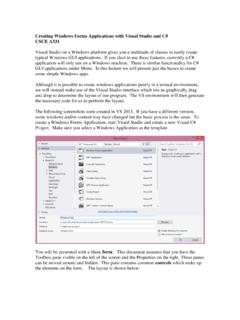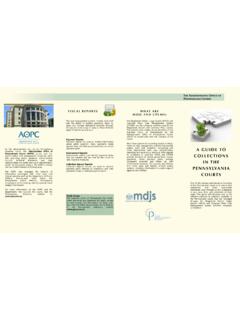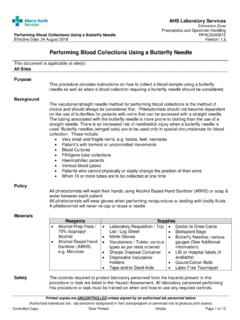Transcription of Standard Template Library and the Java Collections Classes
1 Standard Template Library and the java Collections Classes Both C++ and java have libraries that let us implement common data structures. C++ has STL, the Standard Template Library , and java has the Collections Classes . For high-level applications it is relatively rare to build your own linked list, hash table, binary search tree, etc. Instead these are already implemented for us through these Classes ! Nevertheless the occasion does arise to construct your own class or to modify the class, so it is important to know how the lower-level algorithms work. The easiest way to demonstrate the Classes is through code, so let s go straight to some examples!
2 C++ Standard Template Library Documentation for the Library is here: Here we will just give a few examples for a couple of the Classes in this Library . You ve already been using one of the Classes in this Library , the string class, which abstracts away the messiness of C-style strings terminated by a null character. As the name implies, the Library uses templates. This allows you to substitute the data type of your choice into the class. Vector The vector class is like a cross between an array and a linked list. You can add items dynamically to the vector and access it like an array. Here is an example: #include <iostream> #include <vector> using namespace std; int main( ) { vector<int> v; cout << "Enter a list of positive numbers.}
3 \n" << "Place a negative number at the end.\n"; int next; cin >> next; while (next > 0) { (next); cout << next << " added. "; cout << " ( ) = " << ( ) << endl; cin >> next; } cout << "You entered:\n"; for (unsigned int i = 0; i < ( ); i++) cout << v[i] << " "; cout << endl; return 0; } We can use an iterator to access items in the STL collection . An iterator lets us move back and forth between items in the collection . //Program to demonstrate STL iterators. #include <iostream> #include <vector> using std::cout; using std::endl; using std::vector; using std::vector<int>::iterator; int main( ) { vector<int> container; for (int i = 1; i <= 4; i++) (i); cout << "Here is what is in the container:\n"; iterator p; for (p = ( ); p !)
4 = ( ); p++) cout << *p << " "; cout << endl; cout << "Setting entries to 0:\n"; for (p = ( ); p != ( ); p++) *p = 0; cout << "Container now contains:\n"; for (p = ( ); p != ( ); p++) cout << *p << " "; cout << endl; return 0; } The new C++11 ranged-based for loop and the auto type makes it easy to loop through vectors. This version outputs the numbers in the vector. vector<int> vec; ( 10 ); ( 20 ); for (int i : vec ) { cout << i; } This next version shows how we can edit the items in the vector by specifying a reference. The following increments the numbers in the vector.
5 Vector<int> vec; ( 10 ); ( 20 ); for (int &i : vec ) { I++; } The auto keyword figures out the proper data type based on the type of the expression on the right hand side of the assignment. It is often useful when we have complex data types in the vector. In our case it doesn t save too much: vector<int> vec; ( 10 ); ( 20 ); for (auto i : vec ) { cout << i; } Some other functions we can use on a vector: (iterator, element) o Insert element before the iterator () o Remove all elements () o Return a reference to the front item (iterator) o Remove the element at location Iterator The Standard Template Library also has a list that is similar to a vector, but without the random access.
6 It is basically a linked list. Stack The stack class behaves just like the stack data structure we discussed previously. Here is an example: //Program to demonstrate use of the stack Template class from the STL. #include <iostream> #include <stack> using std::cin; using std::cout; using std::endl; using std::stack; int main( ) { stack<char> s; cout << "Enter a line of text:\n"; char next; (next); while (next != '\n') { (next); (next); } cout << "Written backward that is:\n"; while ( ! ( ) ) { cout << ( ); ( ); } cout << endl; return 0; } The key functions are push, pop, top, and empty.
7 Set The set Template class is, in some sense, the simplest container you can imagine. It stores elements without repetition. The first insertion places an element in the set. Additional insertions after the first have no effect, so that no element appears more than once. Each element is its own key. Basically, you just add or delete elements and ask if an element is in the set or not. Like all STL Classes , the set Template class was written with efficiency as a goal. To work efficiently, a set object stores its values in sorted order. //Program to demonstrate use of the set Template class. #include <iostream> #include <set> using std::cout; using std::endl; using std::set; int main( ) { set<char> s; ('A'); ('D'); ('D'); ('C'); ('C'); ('B'); cout << "The set contains:\n"; for (auto element : s) cout << element << endl; cout << endl; cout << "Set contains 'C': "; if ( ('C') == ()) cout << " no " << endl; else cout << " yes " << endl; cout << "Removing C.}
8 \n"; ('C'); for (auto element : s) cout << element << endl; cout << endl; cout << "Set contains 'C': "; if ( ('C') == ()) cout << " no " << endl; else cout << " yes " << endl; return 0; } Map A map is as an associative array. It could be implemented in a balanced tree, a hash table, etc. A traditional array maps from a numerical index to a value. For example, a[10]=5 would store the number 5 at index 10. An associative array allows you to define your own indices using the data type of your choice. For example, numberMap["c++"]=5 would associate the integer 5 with the string c++ . For convenience, the [] square bracket operator is defined to allow you to use an array-like notation to access a map, although you can also use the insert or find methods if you want.
9 Like a set object, a map object stores its elements sorted by its key values. You can specify the ordering on keys as a third entry in the angular brackets, < >. If you do not specify an ordering, a default ordering is used. The easiest way to add and retrieve data from a map is to use the [] operator. Given a map object m, the expression m[key] will return a reference to the data element associated with key. If no entry exists in the map for key then a new entry will be created with the default value for the data element. This can be used to add a new item to the map or to replace an existing entry. For example, the statement m[key] = newData; will create a new association between key and newData.
10 Note that care must be taken to ensure that map entries are not created by mistake. For example, if you execute the statement val = m[key]; with the intention of retrieving the value associated with key but mistakenly enter a value for key that is not already in the map, then a new entry will be made for key with the default value and assigned into val. #include <map> map<string, string> planets; planets["Mercury"] = "Hot planet"; planets["Venus"] = "Atmosphere of sulfuric acid"; planets["Earth"] = "Home"; planets["Mars"] = "The Red Planet"; planets["Jupiter"] = "Largest planet in our solar system"; planets["Saturn"] = "Has rings"; planets["Uranus"] = "Tilts on its side"; planets["Neptune"] = "1500 mile per hour winds"; planets["Pluto"] = "Dwarf planet"; cout << "Entry for Mercury - " << planets["Mercury"] << endl << endl; if ( ("Mercury") !)














